The 50 Proposed Maxims of neuroELT
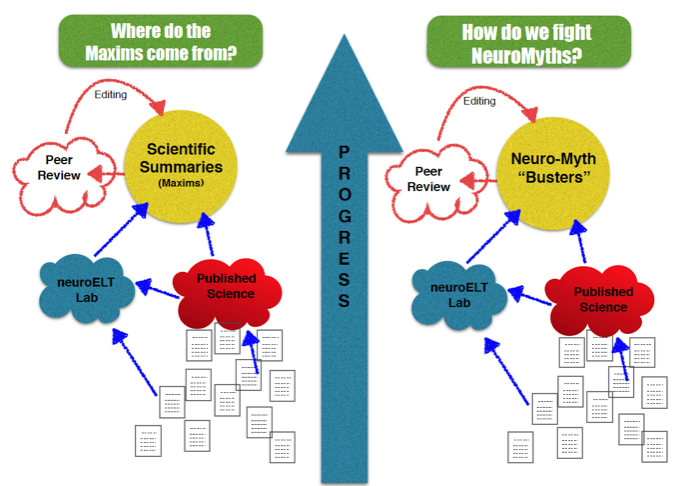
31. "Surprise" me; surprise yourself.
Novelty and happy surprise are very emotional for the body. Not only will positive surprise keep students awake in class, it will help foster alignment and naturally make the lesson more memorable (Wang et al., 2005). Small changes to the regular schedule can be enough to keep students on their toes, but medium surprises such as changing seating patterns and big surprises such as guest speakers or sudden field trips can promote attentive focus and foster lasting impressions (Raz & Buhle, 2006). Give opportunities to students to surprise the teacher as well. As in the maxim above, it helps deliver students and teachers from potential ruts and fosters a more positive social atmosphere. Looking for serendipity while teaching is perhaps the best way to sum up this maxim.
Q. Consider the current unit of study in one of your classrooms. What surprises can you embed into it?
32. "Graphically" organize.
Mind maps and similar "graphic organizer" activities can mimic what is happening in the brain in real time. They helps make the learning/understanding visible. They also enhance focused cognition by creating a dynamic loop of cognition; what happens in the brain affects what happens on paper -- what happens on paper then affects what happens in the brain! This is a wonderful dynamic loop of cognition. Graphic organizers make the students' thought processes tangible and are intriguing for both the teacher and the student; they are dynamically engaging and self-motivating. Let students exchange their mind maps and then interview each other on the content. As long as the root word (seed) of the maps are similar, most students will engage in lively discussions and enhance their communicative skills and deepen their thinking regarding the subject matter. Engaged students with dopamine release show a natural increase in focus and motivation (Storm & Tecott, 2005). Therefore mind mapping before a discussion pretty much guarantees a better and more lively learning experience for any subject matter.
Q. Have you ever done a mind map, or a similar graphic organizer? Where can you implement the usage of mind maps in your current lessons?
33. Decide upon "top-down" and "bottom-up" teaching ratios.
The majority of courses taught in schools, are probably expected to be primarily top down --that is, it is expected that students are to be fed with what teachers deem important and in the teachers' chosen order. Is this not the purpose of school? In that sense, teachers are seen as "dictators of knowledge". This dictatorship is a historical outgrowth of the need to create laborers and managers for the industrial revolution that occurred some 200 years ago. Naturally, back then they had a limited knowledge of how the brain worked. The standard top-down teaching was mostly some form of rote memorization of and the testing of facts that were assumed to be helpful in helping laborers be better laborers. It was all designed to be a short-cut to learning the ropes for those jobs. However, pre-industrial revolution real world learning was mostly bottom-up; nature does not provide classrooms on how to survive in the jungle.
Which is more natural? Which is more humane? The defacto assumption that top-down teaching is always more effective and/or elegant can be utterly false, depending upon your goals. Young children learn languages bottom-up -- that is, they learn languages in their own order, and by their own 'choices' to some extent, although it is all primarily context dependent. Around and after puberty, learners begin to desire top-down learning more strongly because their bottom-up foundation has firmed into and formed their basic self; top-down learning does not affect the established self the way bottom-up learning does. It is not as childish. It is seemingly more elegant. It is indeed the adult way. Pride is not bruised with top-down learning/teaching as much; facts can be learned objectively whereas bottom-up is necessarily objective (humans cannot normally make subjective learning choices). Another reason for the change in preferred learning style around puberty is because the frontal cortex (the executive of the brain) is not, comparatively speaking, as functional at younger ages. Therefore, high brow top-down processing only becomes capable at older ages. These are the physical and psychological reasons why adults often prefer top-down learning and teaching -- and seem to want to teach their students in a top-down format as well. The egocentrism of the adult teacher (and parent) causes adult teachers (and parents) to want to teach top-down. However, now that we have a better understanding of our own cognitive development, and can combat our own egocentric assumptions, we can make a choice -- do we want to teach our students with a top-down methodology for the content before us, or a bottom-up?
Which is the 'better' way? What is the best ratio? This ultimately depends upon the goals and ages of the students. Are you a private language school teacher who wants to retain paying adult language learners? Perhaps the solution would be to supply more top-down nuggets in fun decodable sizes with game-like feedback. You can't expect huge improvements within your student body with such a methodology, but it will keep most adults students coming back for more.
Do you want to produce balanced bilinguals? This is not an easy task. You certainly need to teach more from the bottom-up though. Expect pride to get in the way with adults; you must expect revolt, and therefore, quitters. Bottom-up teaching, if done well, shakes adults' wordly foundations. It is unsettling. However, if your goal is the creation of a well developed L2 self from the bottom up, it is a pragmatic necessity. Many adults are not prepared to be shaken up in this way, even the basics of life have to be relearned in the L2. This is where creativity and liberal thinking makes or breaks the deal. What can be done to enhance bottom-up learning/understanding of the L2? For example, experience a dinner in L2 (bottom-up); don't just read about it from a textbook, that would be top-down. Students must be allowed to follow their passions, experience their passions in L2, access their learning in L2 (metacognition in L2), and ultimately share/present their emotions and understanding in and of the L2.
Q. Think about the different types of teachers you had in your life.Try to recall top-down and bottom-up activities that the teachers had you do. What were the ratios like? What pros and cons do you see with each approach for your own classrooms.
34. "Personalize" the content to captivate students
Is there a more important maxim from the students' point of view? All learning and understanding happens within your students' brains. The learning and understanding must be meaningful for them and hopefully useful for them in the real world. When planning lessons and while teaching your students, keep asking yourself if the content is personal enough, or meaningful enough, for your students. Will your lesson plan captivate your students today? If not, redesign. Old school thinking suggest that teachers know best; new school thinking suggest that students know best. Students may not have the knowledge that you want to give them yet but only they can make that personal connection with the material being covered… so, why must students be captivated? As discussed with other maxims, emotions fuel and guide all learning. Moreover, the RAS (Reticular Activating System) in the lower brain area decides what we should pay attention to or ignore (Willis, 2010).
According to Willis (2010), the RAS makes us alert about (1) physical needs, such as hunger sign or danger signs, (2) executive decisions such as your own plans of the day, or other consequential decisions that you have made, and (3) novelty. As teachers, we all know that repetition and recycling of past material is necessary in most cases. But this can be very, very boring. We all have heard students blurt out, "…but, we already did this yesterday!" Unless students are personally motivated to re-learn what they had just studied yesterday, it is already an uphill battle. How can the students be captivated? Making the learning "personal" is key. Find ways to let the students be egocentric about and with the material. This will captivate them because it is now about them. They now have ownership of the material.
Q. Considering that we are 'massively social creatures', it is natural for humans to want to get personal at some level. What can you do in your current classes to make them more personalized for each student?
35. "Room temperature" matters!
Students learn better if the temperature in the room is cool. Of course 'cool' is different for each student, so the teacher must make his/her best judgment. When a room is hot, it is difficult to study, however, when a room is slightly cool, students become slightly sharper. Use this to your advantage -- and expect warm rooms to produce worse results.
Q. What can you do to keep your students slightly cool?
36. "Lighting conditions" matter!
Context has a direct effect on student outcomes, as can be seen in the above maxim. The amount of light that passes through our eyes also has a great effect on how conscious we are at any given moment. It is a very simple and natural concept that our bodies have learned over thousands of years --darkness automatically prepares our bodies for unconsciousness while light prepares us for consciousness. As simplistic as it may sound, brighter rooms are better for studies while darker rooms are better for resting. So, open the curtains and let the sun in!
Q. What can you do to keep your classrooms bright?
37. "Healthy" bodies make healthy brains; healthy brains make healthy bodies.
It may sound cliché but eating right and exercising right not only makes people healthy -- it makes them smarter too. Several recent studies show that athletic people have brains that work more optimally than people who don't exercise. The same goes with health food versus junk food. People who eat junk food don't think as well as people who eat healthy foods. For example, natural fats are necessary for neuron growth. However, when neurons have to use junk food's trans fats to grow neurons, they produce faulty neurons that don't function optimally. It is a crime that so many schools around the world, including Japan, knowingly serve trans fats (such as in margerine, shortening, and deep fried foods) to unknowing school children who are in the midst of growing neurons for their futures. We should also look out for sugary foods, especially foods with high fructose corn syrup.
Reprimanding students for not doing well while feeding them foods that impede cognitive development is Wrong, with a capital w.
Q. Is your school heath-conscious? What improvements can be made?
38. Establish "Active" break times
How long do you have student sit in their chair per class? If you have a 40 min class, you should have your students stand up and move about at least one time for more optimal cognition. Even the slightest exercise and some sort of stretching can make a big difference in cognitive performance. If you have a 90 min class, this active break time should happen at least twice. Human bodies were not designed to sit and work diligently on a single problem all day long. While we have trained ourselves to do so, it is far from what we are designed to do, and therefore it is not optimal. Incorporating movement into the daily learning activities is a great way to kill two birds with one stone. It give the body its active break time without leaving the studies behind.
Q. Would it be difficult to plan activities that have your students stand up and/or move around every 20 minutes or so? Think of creative ways of doing this!
39. "Meditate" for better learning; go into default mode.
Recent studies in default modes are very intriguing. They tell us that most animals, including humans go into default states when we are not consciously working on a problem. The irony is, our brain immediately starts working on other problems! Our brains never turn themselves off for relaxation. If you have ever had a daydream while waiting at a red light, or while sitting on a train, you know that your mind wanders and sends you information seemingly at random… then suddenly you remember something important! That is our default state working diligently for us in the background. Meditation is a way to access this wonderful background system. Meditation planned usage of our default states. Allow for meditation in the classroom. It may provide deeper insight for your students , help with alignment, and may even help with classroom dynamics.
Q. Have you ever meditated? If not try it! You may be pleasantly surprised with the results! How can this maxim be used in your teaching context?
40. "Spice" up your classroom to engage the other senses
Smells and colors have a strong effect on cognition. Our olfactory nerves are the only sensory nerves that shoot directly into the brain for direct processing; smell is our oldest and most primary sense. In regard to brain affect, vision trumps all other senses. Obviously, these two senses helped us the most when hunting in the jungle. We crave these sensations. Why not take advantage of this in the classroom? Change the smell and décor of the classroom to match the current learning objectives. This could be as simple as changing posters on the wall and/or bringing fragrances into the classroom. If you must lecture, make sure to spice the lecture up with vivid visuals. Don't underestimate the power of touch either. Tactile learning
is not only for children. It is highly effective in adults too.
Teaching material from different perspectives via different senses, forces the brain to manipulate the incoming information in varying ways. This forces the brain to create more elaborate/sophisticated networks for that material as it is being processed. It makes the potential for future access higher because the neuro-network that is created from a multitude of perspectives will necessarily be more intricate and wider-reaching within the brain. It will therefore be easier to find when needed; the bigger the web, the more flies a spider can catch. Using emotional metaphors for synthesis also seems to help arrive at creative solutions that are more memorable too. So, being liberal and even artistic with varying perspectives is not a waste of time, it enhances the brain and helps with creative thinking in general. Art is good.
Although Multiple Intelligences theory (Gardner, 1983) is somewhat controversial, it is controversial because it is often misunderstood. Gardner never designed it to be a prescription for pedagogy, but an observation of how we develop intelligences (via different domains).
Q. How difficult would it be to implement this maxim into your teaching context? No excuses! Get creative with it!
41. Encourage "mistakes"; celebrate mistakes.
Huh? Yes, encourage mistakes. Student who are afraid of making mistakes cannot learn from them, nor can they become good risk-takers. Good learning and creativeness stem from being a risk-taking explorer! Let your students become used to learning from their mistakes. You can even encourage them to make mistakes on purpose -- have them stage mistakes for each other. Then discuss what can be learned from the mistakes that were made. Let mistakes form a natural part of their learning process.
Q. How can you get your students to make mistakes for the sake of learning? In Japan, this may be very difficult. What are your thoughts?
42. Teach for the "DATC"
Teach for the DATC. DATC is an acronym for Dynamic Area of Total Convergence. While teaching language, make sure to cover all three aspects: (1) Socio-cultural, (2) Linguistic, and (3) Non-verbal (feelings). The convergence point (DATC), where all three aspects overlap, is where the strongest and most potent language learning occurs. There are several slides below. Take a moment to understand them all.
Q. What are they three areas that must converge to produce a healthy DATC? Why would this be important? Do you already do this? Which circle is the smallest (gets least coverage) in your classrooms? What can you do to make it more balanced for your students?
Novelty and happy surprise are very emotional for the body. Not only will positive surprise keep students awake in class, it will help foster alignment and naturally make the lesson more memorable (Wang et al., 2005). Small changes to the regular schedule can be enough to keep students on their toes, but medium surprises such as changing seating patterns and big surprises such as guest speakers or sudden field trips can promote attentive focus and foster lasting impressions (Raz & Buhle, 2006). Give opportunities to students to surprise the teacher as well. As in the maxim above, it helps deliver students and teachers from potential ruts and fosters a more positive social atmosphere. Looking for serendipity while teaching is perhaps the best way to sum up this maxim.
Q. Consider the current unit of study in one of your classrooms. What surprises can you embed into it?
32. "Graphically" organize.
Mind maps and similar "graphic organizer" activities can mimic what is happening in the brain in real time. They helps make the learning/understanding visible. They also enhance focused cognition by creating a dynamic loop of cognition; what happens in the brain affects what happens on paper -- what happens on paper then affects what happens in the brain! This is a wonderful dynamic loop of cognition. Graphic organizers make the students' thought processes tangible and are intriguing for both the teacher and the student; they are dynamically engaging and self-motivating. Let students exchange their mind maps and then interview each other on the content. As long as the root word (seed) of the maps are similar, most students will engage in lively discussions and enhance their communicative skills and deepen their thinking regarding the subject matter. Engaged students with dopamine release show a natural increase in focus and motivation (Storm & Tecott, 2005). Therefore mind mapping before a discussion pretty much guarantees a better and more lively learning experience for any subject matter.
Q. Have you ever done a mind map, or a similar graphic organizer? Where can you implement the usage of mind maps in your current lessons?
33. Decide upon "top-down" and "bottom-up" teaching ratios.
The majority of courses taught in schools, are probably expected to be primarily top down --that is, it is expected that students are to be fed with what teachers deem important and in the teachers' chosen order. Is this not the purpose of school? In that sense, teachers are seen as "dictators of knowledge". This dictatorship is a historical outgrowth of the need to create laborers and managers for the industrial revolution that occurred some 200 years ago. Naturally, back then they had a limited knowledge of how the brain worked. The standard top-down teaching was mostly some form of rote memorization of and the testing of facts that were assumed to be helpful in helping laborers be better laborers. It was all designed to be a short-cut to learning the ropes for those jobs. However, pre-industrial revolution real world learning was mostly bottom-up; nature does not provide classrooms on how to survive in the jungle.
Which is more natural? Which is more humane? The defacto assumption that top-down teaching is always more effective and/or elegant can be utterly false, depending upon your goals. Young children learn languages bottom-up -- that is, they learn languages in their own order, and by their own 'choices' to some extent, although it is all primarily context dependent. Around and after puberty, learners begin to desire top-down learning more strongly because their bottom-up foundation has firmed into and formed their basic self; top-down learning does not affect the established self the way bottom-up learning does. It is not as childish. It is seemingly more elegant. It is indeed the adult way. Pride is not bruised with top-down learning/teaching as much; facts can be learned objectively whereas bottom-up is necessarily objective (humans cannot normally make subjective learning choices). Another reason for the change in preferred learning style around puberty is because the frontal cortex (the executive of the brain) is not, comparatively speaking, as functional at younger ages. Therefore, high brow top-down processing only becomes capable at older ages. These are the physical and psychological reasons why adults often prefer top-down learning and teaching -- and seem to want to teach their students in a top-down format as well. The egocentrism of the adult teacher (and parent) causes adult teachers (and parents) to want to teach top-down. However, now that we have a better understanding of our own cognitive development, and can combat our own egocentric assumptions, we can make a choice -- do we want to teach our students with a top-down methodology for the content before us, or a bottom-up?
Which is the 'better' way? What is the best ratio? This ultimately depends upon the goals and ages of the students. Are you a private language school teacher who wants to retain paying adult language learners? Perhaps the solution would be to supply more top-down nuggets in fun decodable sizes with game-like feedback. You can't expect huge improvements within your student body with such a methodology, but it will keep most adults students coming back for more.
Do you want to produce balanced bilinguals? This is not an easy task. You certainly need to teach more from the bottom-up though. Expect pride to get in the way with adults; you must expect revolt, and therefore, quitters. Bottom-up teaching, if done well, shakes adults' wordly foundations. It is unsettling. However, if your goal is the creation of a well developed L2 self from the bottom up, it is a pragmatic necessity. Many adults are not prepared to be shaken up in this way, even the basics of life have to be relearned in the L2. This is where creativity and liberal thinking makes or breaks the deal. What can be done to enhance bottom-up learning/understanding of the L2? For example, experience a dinner in L2 (bottom-up); don't just read about it from a textbook, that would be top-down. Students must be allowed to follow their passions, experience their passions in L2, access their learning in L2 (metacognition in L2), and ultimately share/present their emotions and understanding in and of the L2.
Q. Think about the different types of teachers you had in your life.Try to recall top-down and bottom-up activities that the teachers had you do. What were the ratios like? What pros and cons do you see with each approach for your own classrooms.
34. "Personalize" the content to captivate students
Is there a more important maxim from the students' point of view? All learning and understanding happens within your students' brains. The learning and understanding must be meaningful for them and hopefully useful for them in the real world. When planning lessons and while teaching your students, keep asking yourself if the content is personal enough, or meaningful enough, for your students. Will your lesson plan captivate your students today? If not, redesign. Old school thinking suggest that teachers know best; new school thinking suggest that students know best. Students may not have the knowledge that you want to give them yet but only they can make that personal connection with the material being covered… so, why must students be captivated? As discussed with other maxims, emotions fuel and guide all learning. Moreover, the RAS (Reticular Activating System) in the lower brain area decides what we should pay attention to or ignore (Willis, 2010).
According to Willis (2010), the RAS makes us alert about (1) physical needs, such as hunger sign or danger signs, (2) executive decisions such as your own plans of the day, or other consequential decisions that you have made, and (3) novelty. As teachers, we all know that repetition and recycling of past material is necessary in most cases. But this can be very, very boring. We all have heard students blurt out, "…but, we already did this yesterday!" Unless students are personally motivated to re-learn what they had just studied yesterday, it is already an uphill battle. How can the students be captivated? Making the learning "personal" is key. Find ways to let the students be egocentric about and with the material. This will captivate them because it is now about them. They now have ownership of the material.
Q. Considering that we are 'massively social creatures', it is natural for humans to want to get personal at some level. What can you do in your current classes to make them more personalized for each student?
35. "Room temperature" matters!
Students learn better if the temperature in the room is cool. Of course 'cool' is different for each student, so the teacher must make his/her best judgment. When a room is hot, it is difficult to study, however, when a room is slightly cool, students become slightly sharper. Use this to your advantage -- and expect warm rooms to produce worse results.
Q. What can you do to keep your students slightly cool?
36. "Lighting conditions" matter!
Context has a direct effect on student outcomes, as can be seen in the above maxim. The amount of light that passes through our eyes also has a great effect on how conscious we are at any given moment. It is a very simple and natural concept that our bodies have learned over thousands of years --darkness automatically prepares our bodies for unconsciousness while light prepares us for consciousness. As simplistic as it may sound, brighter rooms are better for studies while darker rooms are better for resting. So, open the curtains and let the sun in!
Q. What can you do to keep your classrooms bright?
37. "Healthy" bodies make healthy brains; healthy brains make healthy bodies.
It may sound cliché but eating right and exercising right not only makes people healthy -- it makes them smarter too. Several recent studies show that athletic people have brains that work more optimally than people who don't exercise. The same goes with health food versus junk food. People who eat junk food don't think as well as people who eat healthy foods. For example, natural fats are necessary for neuron growth. However, when neurons have to use junk food's trans fats to grow neurons, they produce faulty neurons that don't function optimally. It is a crime that so many schools around the world, including Japan, knowingly serve trans fats (such as in margerine, shortening, and deep fried foods) to unknowing school children who are in the midst of growing neurons for their futures. We should also look out for sugary foods, especially foods with high fructose corn syrup.
Reprimanding students for not doing well while feeding them foods that impede cognitive development is Wrong, with a capital w.
Q. Is your school heath-conscious? What improvements can be made?
38. Establish "Active" break times
How long do you have student sit in their chair per class? If you have a 40 min class, you should have your students stand up and move about at least one time for more optimal cognition. Even the slightest exercise and some sort of stretching can make a big difference in cognitive performance. If you have a 90 min class, this active break time should happen at least twice. Human bodies were not designed to sit and work diligently on a single problem all day long. While we have trained ourselves to do so, it is far from what we are designed to do, and therefore it is not optimal. Incorporating movement into the daily learning activities is a great way to kill two birds with one stone. It give the body its active break time without leaving the studies behind.
Q. Would it be difficult to plan activities that have your students stand up and/or move around every 20 minutes or so? Think of creative ways of doing this!
39. "Meditate" for better learning; go into default mode.
Recent studies in default modes are very intriguing. They tell us that most animals, including humans go into default states when we are not consciously working on a problem. The irony is, our brain immediately starts working on other problems! Our brains never turn themselves off for relaxation. If you have ever had a daydream while waiting at a red light, or while sitting on a train, you know that your mind wanders and sends you information seemingly at random… then suddenly you remember something important! That is our default state working diligently for us in the background. Meditation is a way to access this wonderful background system. Meditation planned usage of our default states. Allow for meditation in the classroom. It may provide deeper insight for your students , help with alignment, and may even help with classroom dynamics.
Q. Have you ever meditated? If not try it! You may be pleasantly surprised with the results! How can this maxim be used in your teaching context?
40. "Spice" up your classroom to engage the other senses
Smells and colors have a strong effect on cognition. Our olfactory nerves are the only sensory nerves that shoot directly into the brain for direct processing; smell is our oldest and most primary sense. In regard to brain affect, vision trumps all other senses. Obviously, these two senses helped us the most when hunting in the jungle. We crave these sensations. Why not take advantage of this in the classroom? Change the smell and décor of the classroom to match the current learning objectives. This could be as simple as changing posters on the wall and/or bringing fragrances into the classroom. If you must lecture, make sure to spice the lecture up with vivid visuals. Don't underestimate the power of touch either. Tactile learning
is not only for children. It is highly effective in adults too.
Teaching material from different perspectives via different senses, forces the brain to manipulate the incoming information in varying ways. This forces the brain to create more elaborate/sophisticated networks for that material as it is being processed. It makes the potential for future access higher because the neuro-network that is created from a multitude of perspectives will necessarily be more intricate and wider-reaching within the brain. It will therefore be easier to find when needed; the bigger the web, the more flies a spider can catch. Using emotional metaphors for synthesis also seems to help arrive at creative solutions that are more memorable too. So, being liberal and even artistic with varying perspectives is not a waste of time, it enhances the brain and helps with creative thinking in general. Art is good.
Although Multiple Intelligences theory (Gardner, 1983) is somewhat controversial, it is controversial because it is often misunderstood. Gardner never designed it to be a prescription for pedagogy, but an observation of how we develop intelligences (via different domains).
Q. How difficult would it be to implement this maxim into your teaching context? No excuses! Get creative with it!
41. Encourage "mistakes"; celebrate mistakes.
Huh? Yes, encourage mistakes. Student who are afraid of making mistakes cannot learn from them, nor can they become good risk-takers. Good learning and creativeness stem from being a risk-taking explorer! Let your students become used to learning from their mistakes. You can even encourage them to make mistakes on purpose -- have them stage mistakes for each other. Then discuss what can be learned from the mistakes that were made. Let mistakes form a natural part of their learning process.
Q. How can you get your students to make mistakes for the sake of learning? In Japan, this may be very difficult. What are your thoughts?
42. Teach for the "DATC"
Teach for the DATC. DATC is an acronym for Dynamic Area of Total Convergence. While teaching language, make sure to cover all three aspects: (1) Socio-cultural, (2) Linguistic, and (3) Non-verbal (feelings). The convergence point (DATC), where all three aspects overlap, is where the strongest and most potent language learning occurs. There are several slides below. Take a moment to understand them all.
Q. What are they three areas that must converge to produce a healthy DATC? Why would this be important? Do you already do this? Which circle is the smallest (gets least coverage) in your classrooms? What can you do to make it more balanced for your students?



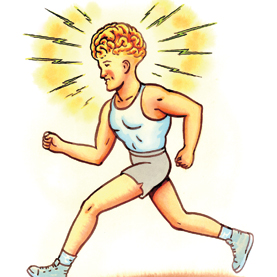

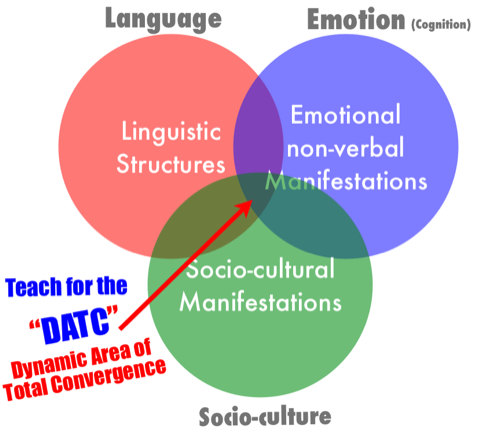
Teach for the DATC. Incorporate all three areas into language teaching and learning for a more natural language learning experience for the learner's brain. All L1 learners learn their L1 in this way. Why not do the same for their L2 learning? Although some adult learners may not like being treated 'like a child', as Teaching the DATC may seem to them on occasion, Teaching for the DATC is actually a much deeper learning experience than the often preferred "rote learning" or "grammar-translation" based methods.
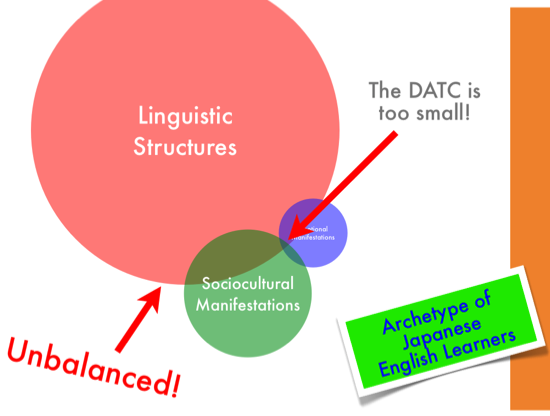
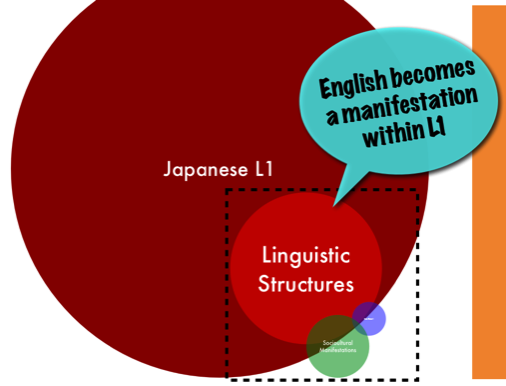
Above are two theoretical models of how/why so many Japanese learners of English in the EFL context so often sound so "Japanese" even when they attempt to speak in English. Through too many years of grammar-translation based teaching, their English is actually a manifestation within their Japanese language network, AND their DATCs are highly unbalanced. Their English cannot exist on it's own. As EFL teachers we have all seen this phenomenon before our eyes and ears.

The above model is an ideal that EFL teachers can strive for. In most cases, totally separate trees (or Dynamic Acquisition Networks) are not realistic, however, the idea is to attempt to foster separate DATCs. Why is this important? It helps nurture balanced bilingualism. In most cases balanced bilingualism can be a useful goal for the teacher and the learner. (In come cases, such as the training for translators, this may be less of a necessity.)
Our newer maxims... write-ups are still being developed at the lab.
43. The earlier the better. Monolingualism is the minority.
44. Balanced bilinguals have an L1 self and an L2 self.
45. Bilinguals use different neural networks per language, but there is overlap.
46. Shy does not mean introvert; introvert does not mean shy.
47. Collaboration boosts levels of cognition.
48. The "labeling" of high-level concepts is a double-edged sword.
49. Don't forget to "rhyme".
50 Language is an "emergent property"; it is a tool of equilibrium with world in which we navigate.
43. The earlier the better. Monolingualism is the minority.
44. Balanced bilinguals have an L1 self and an L2 self.
45. Bilinguals use different neural networks per language, but there is overlap.
46. Shy does not mean introvert; introvert does not mean shy.
47. Collaboration boosts levels of cognition.
48. The "labeling" of high-level concepts is a double-edged sword.
49. Don't forget to "rhyme".
50 Language is an "emergent property"; it is a tool of equilibrium with world in which we navigate.



